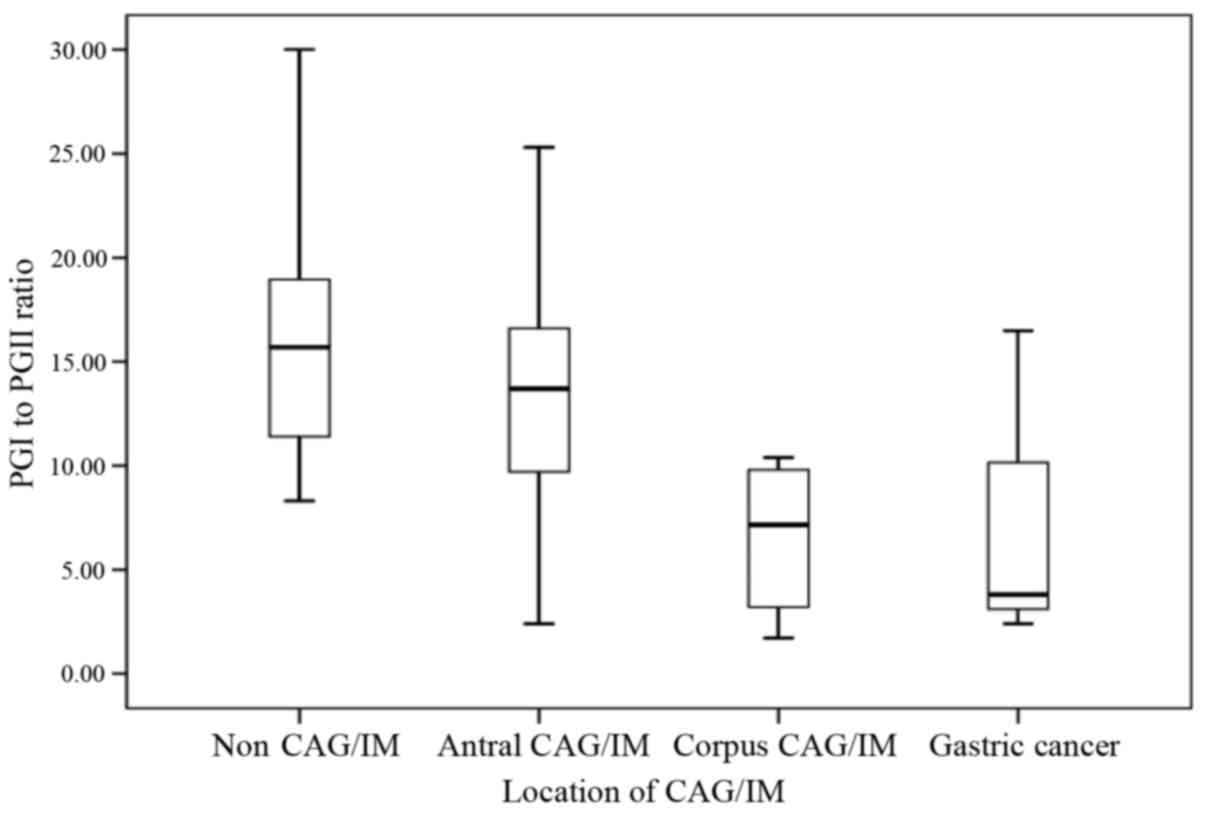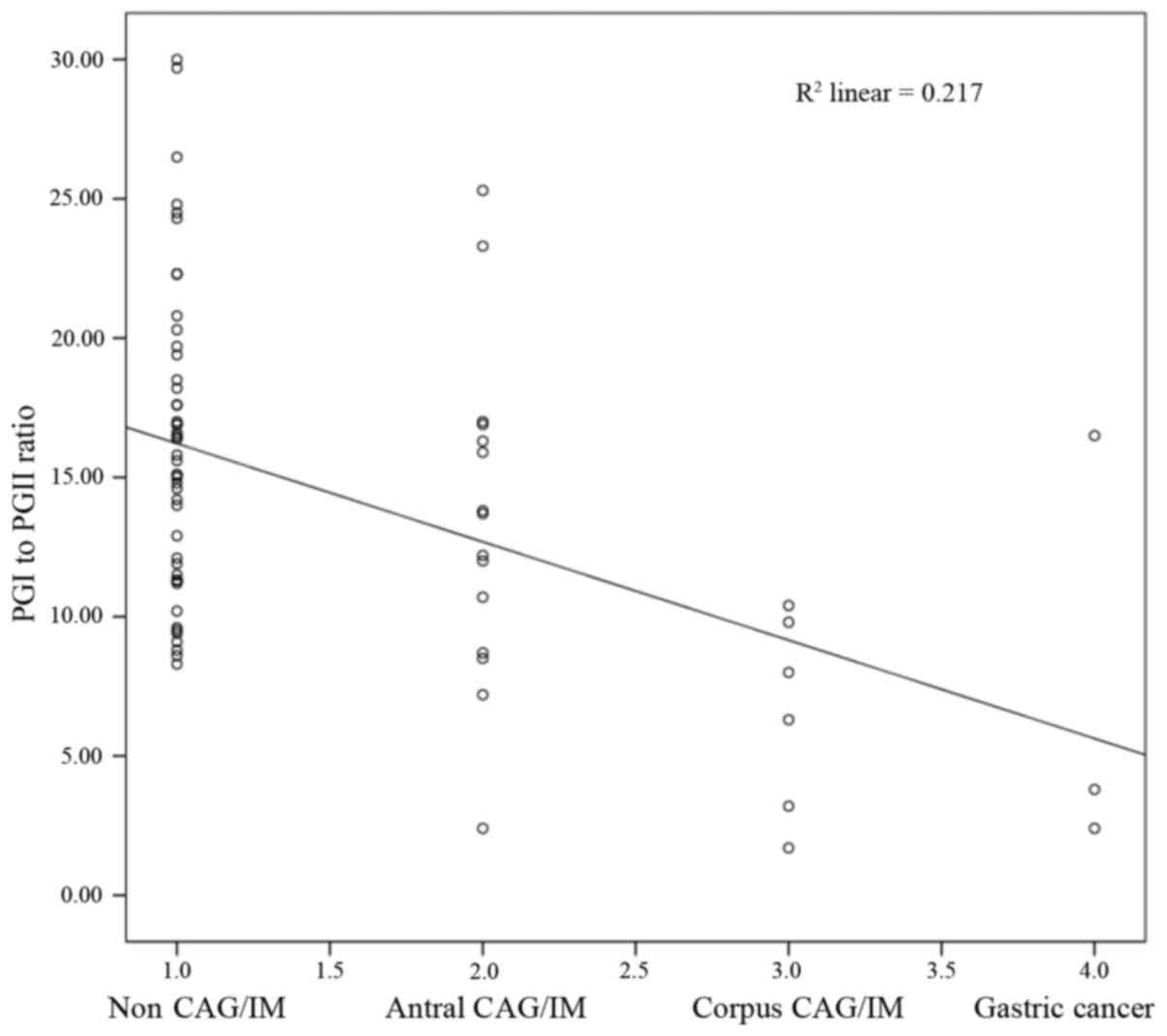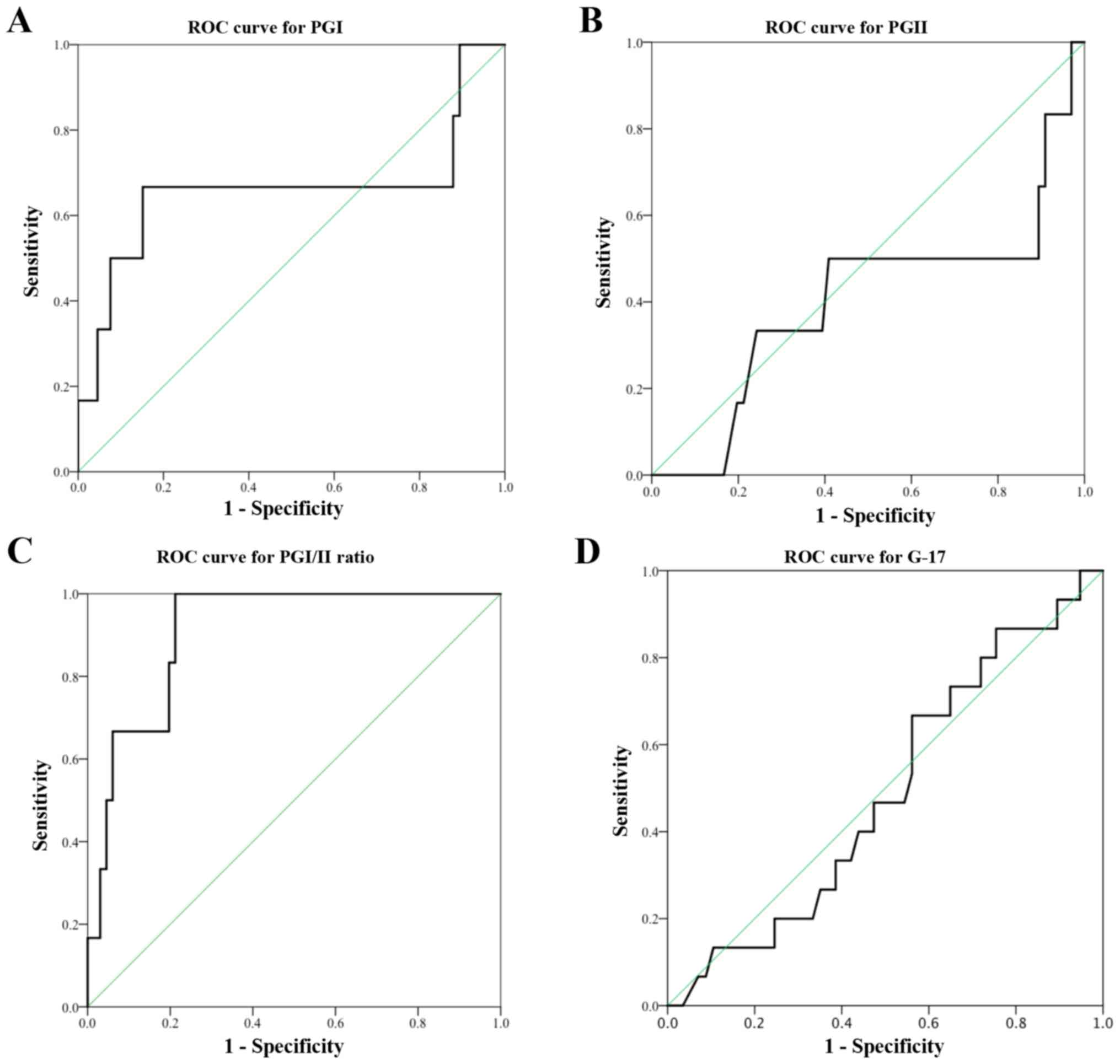|
1
|
Zainal AO and Saleha Nor IT: National
Cancer Registry Report. Malaysia Cancer Statistics - Data and
FigureMinistry of Health Malaysia. Malaysia: 2007
|
|
2
|
Correa P: Human gastric carcinogenesis: A
multistep and multifactorial process - First American Cancer
Society Award Lecture on Cancer Epidemiology and Prevention. Cancer
Res. 52:6735–6740. 1992.PubMed/NCBI
|
|
3
|
Asaka M, Sugiyama T, Nobuta A, Kato M,
Takeda H and Graham DY: Atrophic gastritis and intestinal
metaplasia in Japan: Results of a large multicenter study.
Helicobacter. 6:294–299. 2001. View Article : Google Scholar : PubMed/NCBI
|
|
4
|
Weck MN and Brenner H: Prevalence of
chronic atrophic gastritis in different parts of the world. Cancer
Epidemiol Biomarkers Prev. 15:1083–1094. 2006. View Article : Google Scholar : PubMed/NCBI
|
|
5
|
Sakaki N, Kozawa H, Egawa N, Tu Y and
Sanaka M: Ten-year prospective follow-up study on the relationship
between Helicobacter pylori infection and progression of
atrophic gastritis, particularly assessed by endoscopic findings.
Aliment Pharmacol Ther. 16 Suppl 2:198–203. 2002. View Article : Google Scholar : PubMed/NCBI
|
|
6
|
Sipponen P: Update on the pathologic
approach to the diagnosis of gastritis, gastric atrophy, and
Helicobacter pylori and its sequelae. J Clin Gastroenterol.
32:196–202. 2001. View Article : Google Scholar : PubMed/NCBI
|
|
7
|
Park YH and Kim N: Review of atrophic
gastritis and intestinal metaplasia as a premalignant lesion of
gastric cancer. J Cancer Prev. 20:25–40. 2015. View Article : Google Scholar : PubMed/NCBI
|
|
8
|
Tatsuta M, Iishi H, Nakaizumi A, Okuda S,
Taniguchi H, Hiyama T, Tsukuma H and Oshima A: Fundal atrophic
gastritis as a risk factor for gastric cancer. Int J Cancer.
53:70–74. 1993. View Article : Google Scholar : PubMed/NCBI
|
|
9
|
Whiting JL, Sigurdsson A, Rowlands DC,
Hallissey MT and Fielding JW: The long term results of endoscopic
surveillance of premalignant gastric lesions. Gut. 50:378–381.
2002. View Article : Google Scholar : PubMed/NCBI
|
|
10
|
de Vries AC, van Grieken NC, Looman CW,
Casparie MK, de Vries E, Meijer GA and Kuipers EJ: Gastric cancer
risk in patients with premalignant gastric lesions: A nationwide
cohort study in the Netherlands. Gastroenterology. 134:945–952.
2008. View Article : Google Scholar : PubMed/NCBI
|
|
11
|
Hansen S, Vollset SE, Derakhshan MH, Fyfe
V, Melby KK, Aase S, Jellum E and McColl KE: Two distinct
aetiologies of cardia cancer; evidence from premorbid serological
markers of gastric atrophy and Helicobacter pylori status.
Gut. 56:918–925. 2007. View Article : Google Scholar : PubMed/NCBI
|
|
12
|
Hallissey MT, Dunn JA and Fielding JW:
Evaluation of pepsinogen A and gastrin-17 as markers of gastric
cancer and high-risk pathologic conditions. Scand J Gastroenterol.
29:1129–1134. 1994. View Article : Google Scholar : PubMed/NCBI
|
|
13
|
Sipponen P, Ranta P, Helske T, Kääriäinen
I, Mäki T, Linnala A, Suovaniemi O, Alanko A and Härkönen M: Serum
levels of amidated gastrin-17 and pepsinogen I in atrophic
gastritis: An observational case-control study. Scand J
Gastroenterol. 37:785–791. 2002. View Article : Google Scholar : PubMed/NCBI
|
|
14
|
Dinis-Ribeiro M, da Costa-Pereira A, Lopes
C, Barbosa J, Guilherme M, Moreira-Dias L, Lomba-Viana H, Silva R,
Abreu N and Lomba-Viana R: Validity of serum pepsinogen I/II ratio
for the diagnosis of gastric epithelial dysplasia and intestinal
metaplasia during the follow-up of patients at risk for
intestinal-type gastric adenocarcinoma. Neoplasia. 6:449–456. 2004.
View Article : Google Scholar : PubMed/NCBI
|
|
15
|
Storskrubb T, Aro P, Ronkainen J, Sipponen
P, Nyhlin H, Talley NJ, Engstrand L, Stolte M, Vieth M, Walker M
and Agréus L: Serum biomarkers provide an accurate method for
diagnosis of atrophic gastritis in a general population: The
Kalixanda study. Scand J Gastroenterol. 43:1448–1455. 2008.
View Article : Google Scholar : PubMed/NCBI
|
|
16
|
Lomba-Viana R, Dinis-Ribeiro M, Fonseca F,
Vieira AS, Bento MJ and Lomba-Viana H: Serum pepsinogen test for
early detection of gastric cancer in a European country. Eur J
Gastroenterol Hepatol. 24:37–41. 2012. View Article : Google Scholar : PubMed/NCBI
|
|
17
|
Zhang XM, Li JX, Zhang GY, Li XH and Gu H:
The value of serum pepsinogen levels for the diagnosis of gastric
diseases in Chinese Han people in midsouth China. BMC
Gastroenterol. 14:32014. View Article : Google Scholar : PubMed/NCBI
|
|
18
|
McNicholl AG, Forné M, Barrio J, De la
Coba C, González B, Rivera R, Esteve M, Fernandez-Bañares F,
Madrigal B, Gras-Miralles B, et al: Helicobacter pylori
Study Group of Asociación Española de Gastroenterología (AEG):
Accuracy of GastroPanel for the diagnosis of atrophic gastritis.
Eur J Gastroenterol Hepatol. 26:941–948. 2014. View Article : Google Scholar : PubMed/NCBI
|
|
19
|
Inoue M, Kobayashi S, Matsuura A, Hamajima
N, Tajima K and Tominaga S: Agreement of endoscopic findings and
serum pepsinogen levels as an indicator of atrophic gastritis.
Cancer Epidemiol Biomarkers Prev. 7:261–263. 1998.PubMed/NCBI
|
|
20
|
Ley C, Mohar A, Guarner J,
Herrera-Goepfert R, Figueroa LS, Halperin D and Parsonnet J:
Screening markers for chronic atrophic gastritis in Chiapas,
Mexico. Cancer Epidemiol Biomarkers Prev. 10:107–112.
2001.PubMed/NCBI
|
|
21
|
Väänänen H, Vauhkonen M, Helske T,
Kääriäinen I, Rasmussen M, Tunturi-Hihnala H, Koskenpato J, Sotka
M, Turunen M, Sandström R, et al: Non-endoscopic diagnosis of
atrophic gastritis with a blood test. Correlation between gastric
histology and serum levels of gastrin-17 and pepsinogen I: A
multicentre study. Eur J Gastroenterol Hepatol. 15:885–891. 2003.
View Article : Google Scholar : PubMed/NCBI
|
|
22
|
Sierra R, Une C, Ramírez V, González MI,
Ramírez JA, de Mascarel A, Barahona R, Salas-Aguilar R, Páez R,
Avendaño G, et al: Association of serum pepsinogen with atrophic
body gastritis in Costa Rica. Clin Exp Med. 6:72–78. 2006.
View Article : Google Scholar : PubMed/NCBI
|
|
23
|
Oishi Y, Kiyohara Y, Kubo M, Tanaka K,
Tanizaki Y, Ninomiya T, Doi Y, Shikata K, Yonemoto K, Shirota T, et
al: The serum pepsinogen test as a predictor of gastric cancer: The
Hisayama study. Am J Epidemiol. 163:629–637. 2006. View Article : Google Scholar : PubMed/NCBI
|
|
24
|
Mohamadkhani A, Moghaddam Darvish S,
Salmanroghani H, Allafsghari A, Yazdanbod A, Mirzaei M,
Haj-sheykholeslami A, Bashiri J, Sadjadi A and Massarrat S: Are the
serum biomarkers pepsinogen I and II good predictors for the
detection of subjects with atrophic gastritis in areas that have
different gastric cancer incidence? Arch Iran Med. 16:208–212.
2013.PubMed/NCBI
|
|
25
|
You WC, Blot WJ, Li JY, Chang YS, Jin ML,
Kneller R, Zhang L, Han ZX, Zeng XR, Liu WD, et al: Precancerous
gastric lesions in a population at high risk of stomach cancer.
Cancer Res. 53:1317–1321. 1993.PubMed/NCBI
|
|
26
|
Broutet N, Plebani M, Sakarovitch C,
Sipponen P and Mégraud F: Eurohepygast Study Group: Pepsinogen A,
pepsinogen C, and gastrin as markers of atrophic chronic gastritis
in European dyspeptics. Br J Cancer. 88:1239–1247. 2003. View Article : Google Scholar : PubMed/NCBI
|
|
27
|
Lee JY, Kim N, Lee HS, Oh JC, Kwon YH,
Choi YJ, Yoon KC, Hwang JJ, Lee HJ, Lee A, et al: Correlations
among endoscopic, histologic and serologic diagnoses for the
assessment of atrophic gastritis. J Cancer Prev. 19:47–55. 2014.
View Article : Google Scholar : PubMed/NCBI
|
|
28
|
Compare D, Rocco A and Nardone G: Risk
factors in gastric cancer. Eur Rev Med Pharmacol Sci. 14:302–308.
2010.PubMed/NCBI
|
|
29
|
Ding SZ, Goldberg JB and Hatakeyama M:
Helicobacter pylori infection, oncogenic pathways and
epigenetic mechanisms in gastric carcinogenesis. Future Oncol.
6:851–862. 2010. View Article : Google Scholar : PubMed/NCBI
|
|
30
|
Chang YW, Hwangbo Y, Lee JW, Jo SJ, Cho
JH, Shim J, Jang JY, Kim HJ and Kim BH: Clinical parameters
including serum pepsinogen level and management strategy in
patients with premalignant gastric dysplasia. Eur J Gastroenterol
Hepatol. 23:405–410. 2011. View Article : Google Scholar : PubMed/NCBI
|
|
31
|
Shin CM, Kim N, Yang HJ, Cho SI, Lee HS,
Kim JS, Jung HC and Song IS: Stomach cancer risk in gastric cancer
relatives: Interaction between Helicobacter pylori infection
and family history of gastric cancer for the risk of stomach
cancer. J Clin Gastroenterol. 44:e34–e39. 2010. View Article : Google Scholar : PubMed/NCBI
|
|
32
|
El Hajj II, Hashash JG, Baz EM, Abdul-Baki
H and Sharara AI: ABO blood group and gastric cancer: Rekindling an
old fire? South Med J. 100:726–727. 2007. View Article : Google Scholar : PubMed/NCBI
|
|
33
|
Mao Y, Hu J, Semenciw R and White K:
Canadian Cancer Registries Epidemiology Research Group: Active and
passive smoking and the risk of stomach cancer, by subsite, in
Canada. Eur J Cancer Prev. 11:27–38. 2002. View Article : Google Scholar : PubMed/NCBI
|
|
34
|
Kimura KTT and Takemoto T: An endoscopic
recognization of the atrophic border and its significance in
chronic gastritis. Endoscopy. 1:87–97. 1969. View Article : Google Scholar
|
|
35
|
Miike T, Yamamoto S, Miyata Y, Hirata T,
Noda Y, Noda T, Suzuki S, Takeda S, Natsuda S, Sakaguchi M, et al:
Surrounding gastric mucosa findings facilitate diagnosis of gastric
neoplasm as gastric adenoma or early gastric cancer. Gastroenterol
Res Pract. 2016:65276532016. View Article : Google Scholar : PubMed/NCBI
|
|
36
|
Dixon MF, Genta RM, Yardley JH and Correa
P: Classification and grading of gastritis. The updated Sydney
System. International Workshop on the Histopathology of Gastritis,
Houston 1994. Am J Surg Pathol. 20:1161–1181. 1996. View Article : Google Scholar : PubMed/NCBI
|
|
37
|
Kitahara F, Kobayashi K, Sato T, Kojima Y,
Araki T and Fujino MA: Accuracy of screening for gastric cancer
using serum pepsinogen concentrations. Gut. 44:693–697. 1999.
View Article : Google Scholar : PubMed/NCBI
|
|
38
|
Miki K: Gastric cancer screening using the
serum pepsinogen test method. Gastric Cancer. 9:245–53. 2006.
View Article : Google Scholar : PubMed/NCBI
|
|
39
|
Miki K, Fujishiro M, Kodashima S and
Yahagi N: Long-term results of gastric cancer screening using the
serum pepsinogen test method among an asymptomatic middle-aged
Japanese population. Dig Endosc. 21:78–81. 2009. View Article : Google Scholar : PubMed/NCBI
|
|
40
|
Borch K, Axelsson CK, Halgreen H, Nielsen
Damkjaer MD, Ledin T and Szesci PB: The ratio of pepsinogen A to
pepsinogen C: A sensitive test for atrophic gastritis. Scand J
Gastroenterol. 24:870–876. 1989. View Article : Google Scholar : PubMed/NCBI
|
|
41
|
Zhang Z, Sun L, Gong YH, Wang XG, Zhang M
and Yuan Y: Factors affecting the serum gastrin 17 level: An
evidence-based analysis of 3906 serum samples among Chinese. J Dig
Dis. 8:72–76. 2007. View Article : Google Scholar : PubMed/NCBI
|
|
42
|
Sipponen P, Vauhkonen M, Helske T,
Kaariainen I and Harkonen M: Low circulating levels of gastrin-17
in patients with Barrett's esophagus. World J Gastroenterol.
11:5988–5992. 2005. View Article : Google Scholar : PubMed/NCBI
|
|
43
|
Yuan Y: A survey and evaluation of
population-based screening for gastric cancer. Cancer Biol Med.
10:72–80. 2013.PubMed/NCBI
|
|
44
|
Wang X, Ling L, Li S, Qin G, Cui W, Li X
and Ni H: The diagnostic value of gastrin-17 detection in atrophic
gastritis: A meta-analysis. Medicine (Baltimore). 95:e35992016.
View Article : Google Scholar : PubMed/NCBI
|












